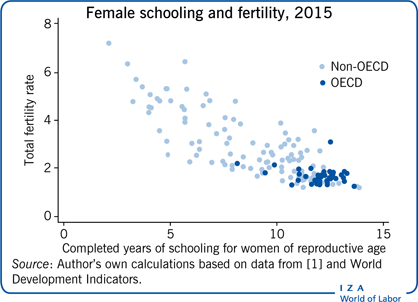Elevator pitch
The negative correlation between women's education and fertility has been observed across regions and time, although it is now weaker among high-income countries. Women's education level could affect fertility through its impact on women's health and their physical capacity to give birth, children's health, the number of children desired, and women's ability to control birth and knowledge of different birth control methods. Each of these mechanisms depends on the individual, institutional, and country circumstances experienced. Their relative importance may change along a country's economic development process.
Key findings
Pros
The fertility gap between women with primary versus no education widens as incomes increase, but decreases at higher (secondary versus primary) education levels.
Educated women are more physically capable of giving birth than uneducated women; but want fewer children and control birth better.
Educated women provide better care at home, thus increasing the value of their children’s human capital and reducing the need for more children.
At relatively early stages of a country’s development, educated women adopt modern birth control methods more often than uneducated women.
Cons
The negative correlation between female schooling and fertility is strong, but it varies at different levels of women’s education and stages of a country’s development.
With paid childcare or cooperative husbands, educated women may want to work more and have more children than uneducated women.
Parents’ ability to generate wealth may be transferred to their children through investment in children’s human capital.
It is unclear whether education increases women’s access to new information or their ability to adopt new birth control technology.
